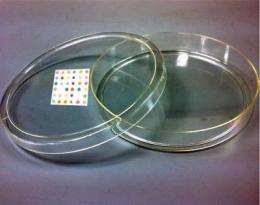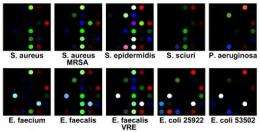Get a whiff of this: Low-cost sensor can diagnose bacterial infections

Bacterial infections really stink. And that could be the key to a fast diagnosis.
Researchers have demonstrated a quick, simple method to identify infectious bacteria by smell using a low-cost array of printed pigments as a chemical sensor. Led by University of Illinois chemistry professor Ken Suslick, the team published its results in the Journal of the American Chemical Society.
Hospitals have used blood cultures as the standard for identifying blood-borne bacterial infections for more than a century. While there have been some improvements in automating the process, the overall method has remained largely constant. Blood samples are incubated in vials for 24 to 48 hours, when a carbon dioxide sensor in the vials will signal the presence of bacteria. But after a culture is positive, doctors still need to identify which species and strain of bacteria is in the vial, a process that takes up to another day.
"The major problem with the clinical blood culturing is that it takes too long," said Suslick, the Marvin T. Schmidt professor of chemistry, who also is a professor of materials science and engineering and a member of the Beckman Institute for Advanced Science and Technology. "In 72 hours they may have diagnosed the problem, but the patient may already have died of sepsis."
While there has been some interest in using sophisticated spectroscopy or genetic methods for clinical diagnosis, Suslick's group focused on another distinctive characteristic: smell. Many experienced microbiologists can identify bacteria based on their aroma. Bacteria emit a complex mixture of chemicals as by-products of their metabolism. Each species of bacteria produces its own unique blend of gases, and even differing strains of the same species will have an aromatic "fingerprint."
An expert in chemical sensing, Suslick previously developed an artificial "nose" that can detect and identify poisonous gases, toxins and explosives in the air.
"Our approach to this problem has been to think of bacteria as simply micron-sized chemical factories whose exhaust is not regulated by the EPA," Suslick said. "Our technology is now well-proven for detecting and distinguishing among different chemical odorants, so applying it to bacteria was not much of a stretch."

The artificial nose is an array of 36 cross-reactive pigment dots that change color when they sense chemicals in the air. The researchers spread blood samples on Petri dishes of a standard growth gel, attached an array to the inside of the lid of each dish, then inverted the dishes onto an ordinary flatbed scanner. Every 30 minutes, they scanned the arrays and recorded the color changes in each dot. The pattern of color change over time is unique to each bacterium.
"The progression of the pattern change is part of the diagnosis of which bacteria it is," Suslick said. "It's like time-lapse photography. You're not looking just at a single frame, you're looking at the motion of the frames over time."
In only a few hours, the array not only confirms the presence of bacteria, but identifies a specific species and strain. It even can recognize antibiotic resistance – a key factor in treatment decisions.
In the paper, the researchers showed that they could identify 10 of the most common disease-causing bacteria, including the hard-to-kill hospital infection methicillin-resistant Staphylococcus aureus (MRSA), with 98.8 percent accuracy. However, Suslick believes the array could be used to diagnose a much wider variety of infections.
"We don't have an upper limit. We haven't yet found any bacteria that we can't detect and distinguish from other bacteria," he said. "We picked out a sampling of human pathogenic bacteria as a starting point."
Given their broad sensitivity, the chemical-sensing arrays also could enable breath diagnosis for a number of conditions. Medical researchers at other institutions have already performed studies using Suslick's arrays to diagnose sinus infections and to screen for lung cancer.
Next, the team is working on integrating the arrays with vials of liquid growth medium, which is a faster culturing agent and more common in clinical practice than Petri dishes. They have also improved the pigments to be more stable, more sensitive and easier to print. The device company iSense, which Suslick co-founded, is commercializing the array technology for clinical use.
More information: "Rapid Identification of Bacteria with a Disposable Colorimetric Sensing Array," pubs.acs.org/doi/abs/10.1021/ja201634d
Abstract
Rapid identification of both species and even specific strains of human pathogenic bacteria grown on standard agar has been achieved from the volatiles they produce using a disposable colorimetric sensor array in a Petri dish imaged with an inexpensive scanner. All 10 strains of bacteria tested, including Enterococcus faecalis and Staphylococcus aureus and their antibiotic-resistant forms, were identified with 98.8% accuracy within 10 h, a clinically important time frame. Furthermore, the colorimetric sensor arrays also proved useful as a simple research tool for the study of bacterial metabolism and as an easy method for the optimization of bacterial production of fine chemicals or other fermentation processes.
Provided by University of Illinois at Urbana-Champaign

















